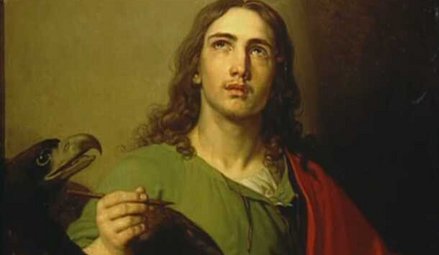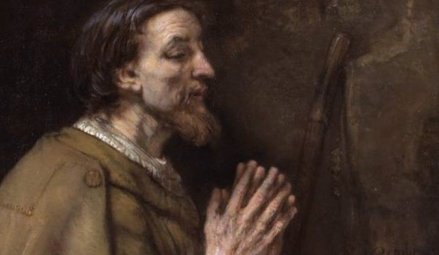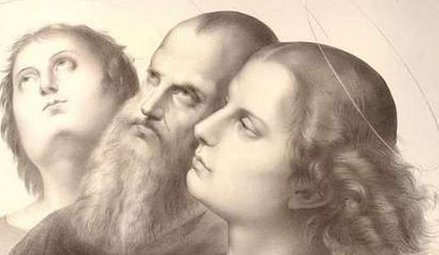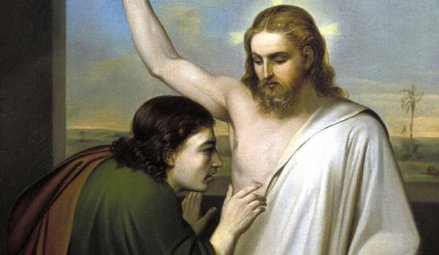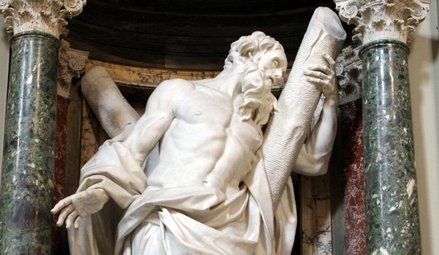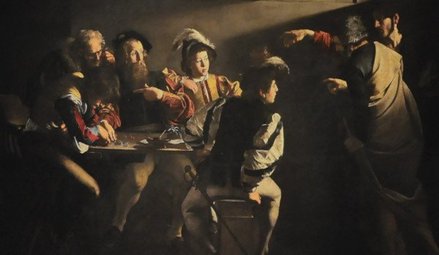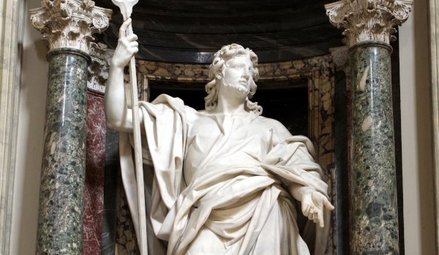- By theme
- Jesus
- The many proofs of Christ’s resurrection
- Saint Thomas Aquinas: God gave all the divine proofs we needed to believe
- The surpassing power of Christ's word
- Lewis’s trilemma: a proof of Jesus’s divinity
- God saves: the power of the holy name of Jesus
- Jesus spoke and acted as God's equal
- Jesus' divinity is actually implied in the Koran
- Jesus came at the perfect time of history
- Rabbinical sources testify to Jesus' miracles
- Mary
- The Church
- The Bible
- An enduring prophecy and a series of miraculous events preventing the reconstruction of the Temple
- The authors of the Gospels were either eyewitnesses or close contacts of those eyewitnesses
- Onomastics support the historical reliability of the Gospels
- The New Testament was not altered
- The New Testament is the best-attested manuscript of Antiquity
- The Gospels were written too early after the facts to be legends
- Archaeological finds confirm the reliability of the New Testament
- The criterion of embarrassment proves that the Gospels tell the truth
- The dissimilarity criterion strengthens the case for the historical reliability of the Gospels
- 84 details in Acts verified by historical and archaeological sources
- The unique prophecies that announced the Messiah
- The time of the coming of the Messiah was accurately prophesied
- The prophet Isaiah's ultra accurate description of the Messiah's sufferings
- Daniel's "Son of Man" is a portrait of Christ
- The Apostles
- Saint Peter, prince of the apostles
- Saint John the Apostle: an Evangelist and Theologian who deserves to be better known (d. 100)
- Saint Matthew, apostle, evangelist and martyr (d. 61)
- James the Just, “brother” of the Lord, apostle and martyr (d. 62 AD)
- Saint Matthias replaces Judas as an apostle (d. 63)
- The martyrs
- The protomartyr Saint Stephen (d. 31)
- Polycarp, bishop of Smyrna, disciple of John and martyr (d. 155)
- Justin Martyr: philosopher and apologist (d.165)
- Saint Blandina and the Martyrs of Lyon: the fortitude of faith (177 AD)
- Saint Agatha stops a volcano from destroying the city of Catania (d. 251)
- Saint Lucy of Syracuse, virgin and martyr for Christ (d. 304)
- Saint Boniface propagates Christianity in Germany (d. 754)
- Thomas More: “The king’s good servant, but God’s first”
- The martyrdom of Paul Miki and his companions (d. 1597)
- The martyrs of Angers and Avrillé (1794)
- The Martyrs of Compiègne (1794)
- The Vietnamese martyrs Father Andrew Dung-Lac and his 116 companions (17th-19th centuries)
- He braved torture to atone for his apostasy (d. 1818)
- Blaise Marmoiton: the epic journey of a missionary to New Caledonia (d. 1847)
- The Uganda martyrs: a recurring pattern in the persecution of Christians (1885)
- José Luis Sanchez del Rio, martyred at age 14 for Christ the King (d. 1928)
- Saint Maximilian Kolbe, Knight of the Immaculate (d. 1941)
- The monks
- The Desert Fathers (3rd century)
- Saint Anthony of the Desert, a father of monasticism (d. 356)
- Saint Benedict, father of Western monasticism (d. 550)
- Saint Bruno the Carthusian (d.1101): the miracle of a hidden life
- Blessed Angelo Agostini Mazzinghi: the Carmelite with flowers pouring from his mouth (d. 1438)
- Monk Abel of Valaam's accurate prophecies about Russia (d. 1841)
- The more than 33,000 miracles of Saint Charbel Maklouf (d. 1898)
- Saint Pio of Pietrelcina (d. 1968): How God worked wonders through "a poor brother who prays"
- The surprising death of Father Emmanuel de Floris (d. 1992)
- The prophecies of Saint Paisios of Mount Athos (d. 1994)
- The saints
- Saints Anne and Joachim, parents of the Virgin Mary (19 BC)
- Saint Nazarius, apostle and martyr (d. 68 or 70)
- Ignatius of Antioch: successor of the apostles and witness to the Gospel (d. 117)
- Saint Gregory the Miracle-Worker (d. 270)
- Saint Martin of Tours: patron saint of France, father of monasticism in Gaul, and the first great leader of Western monasticism (d. 397)
- Saint Augustine of Canterbury evangelises England (d. 604)
- Saint Lupus, the bishop who saved his city from the Huns (d. 623)
- Saint Rainerius of Pisa: from musician to merchant to saint (d. 1160)
- Saint Dominic of Guzman (d.1221): an athlete of the faith
- Saint Francis, the poor man of Assisi (d. 1226)
- Saint Anthony of Padua: "everyone’s saint"
- Saint Rose of Viterbo or How prayer can transform the world (d. 1252)
- Saint Simon Stock receives the scapular of Mount Carmel from the hands of the Virgin Mary
- The unusual boat of Saint Basil of Ryazan
- Saint Agnes of Montepulciano's complete God-confidence (d. 1317)
- The extraordinary conversion of Michelina of Pesaro
- Saint Peter Thomas (d. 1366): a steadfast trust in the Virgin Mary
- Saint Rita of Cascia: hoping against all hope
- Saint Catherine of Genoa and the Fire of God's love (d. 1510)
- Saint Anthony Mary Zaccaria, physician of bodies and souls (d. 1539)
- Saint Ignatius of Loyola (d. 1556): "For the greater glory of God"
- Brother Alphonsus Rodríguez, SJ: the "holy porter" (d. 1617)
- Martin de Porres returns to speed up his beatification (d. 1639)
- Virginia Centurione Bracelli: When God is the only goal, all difficulties are overcome (d.1651)
- Saint Marie of the Incarnation, "the Teresa of New France" (d.1672)
- St. Francis di Girolamo's gift of reading hearts and souls (d. 1716)
- Rosa Venerini: moving in the ocean of the Will of God (d. 1728)
- Saint Jeanne-Antide Thouret: heroic perseverance and courage (d. 1826)
- Seraphim of Sarov (1759-1833): the purpose of the Christian life is to acquire the Holy Spirit
- Camille de Soyécourt, filled with divine fortitude (d. 1849)
- Bernadette Soubirous, the shepherdess who saw the Virgin Mary (1858)
- Saint John Vianney (d. 1859): the global fame of a humble village priest
- Gabriel of Our Lady of Sorrows, the "Gardener of the Blessed Virgin" (d. 1862)
- Father Gerin, the holy priest of Grenoble (1863)
- Blessed Francisco Palau y Quer: a lover of the Church (d. 1872)
- Saints Louis and Zelie Martin, the parents of Saint Therese of Lisieux (d. 1894 and 1877)
- The supernatural maturity of Francisco Marto, “contemplative consoler of God” (d. 1919)
- Saint Faustina, apostle of the Divine Mercy (d. 1938)
- Brother Marcel Van (d.19659): a "star has risen in the East"
- Doctors
- The mystics
- Lutgardis of Tongeren and the devotion to the Sacred Heart
- Saint Angela of Foligno (d. 1309) and "Lady Poverty"
- Saint John of the Cross: mystic, reformer, poet, and universal psychologist (+1591)
- Blessed Anne of Jesus: a Carmelite nun with mystical gifts (d.1621)
- Catherine Daniélou: a mystical bride of Christ in Brittany
- Saint Margaret Mary sees the "Heart that so loved mankind"
- Jesus makes Maria Droste zu Vischering the messenger of his Divine Heart (d. 1899)
- Mother Yvonne-Aimée of Jesus' predictions concerning the Second World War (1922)
- Sister Josefa Menendez, apostle of divine mercy (d. 1923)
- Edith Royer (d. 1924) and the Sacred Heart Basilica of Montmartre
- Rozalia Celak, a mystic with a very special mission (d. 1944)
- Visionaries
- Saint Perpetua delivers her brother from Purgatory (203)
- María de Jesús de Ágreda, abbess and friend of the King of Spain
- Discovery of the Virgin Mary's house in Ephesus (1891)
- Sister Benigna Consolata: the "Little Secretary of Merciful Love" (d. 1916)
- Maria Valtorta's visions match data from the Israel Meteorological Service (1943)
- Berthe Petit's prophecies about the two world wars (d. 1943)
- Maria Valtorta saw only one pyramid at Giza in her visions... and she was right! (1944)
- The location of Saint Peter's village seen in a vision before its archaeological discovery (1945)
- The 700 extraordinary visions of the Gospel received by Maria Valtorta (d. 1961)
- The amazing geological accuracy of Maria Valtorta's writings (d. 1961)
- Maria Valtorta's astronomic observations consistent with her dating system
- Discovery of an ancient princely house in Jerusalem, previously revealed to a mystic (d. 1961)
- Mariette Kerbage, the seer of Aleppo (1982)
- The 20,000 icons of Mariette Kerbage (2002)
- The popes
- The great witnesses of the faith
- Saint Augustine's conversion: "Why not this very hour make an end to my uncleanness?" (386)
- Thomas Cajetan (d. 1534): a life in service of the truth
- Madame Acarie, "the servant of the servants of God" (d. 1618)
- Blaise Pascal (d.1662): Biblical prophecies are evidence
- Madame Élisabeth and the sweet smell of virtue (d. 1794)
- Jacinta, 10, offers her suffering to save souls from hell (d. 1920)
- Father Jean-Édouard Lamy: "another Curé of Ars" (d. 1931)
- Christian civilisation
- The depth of Christian spirituality
- John of the Cross' Path to perfect union with God based on his own experience
- The dogma of the Trinity: an increasingly better understood truth
- The incoherent arguments against Christianity
- The "New Pentecost": modern day, spectacular outpouring of the Holy Spirit
- The Christian faith explains the diversity of religions
- Cardinal Pierre de Bérulle (d.1629) on the mystery of the Incarnation
- Christ's interventions in history
- Marian apparitions and interventions
- The Life-giving Font of Constantinople
- Apparition of Our Lady of La Treille in northern France: prophecy and healings (600)
- Our Lady of Virtues saves the city of Rennes in Bretagne (1357)
- Mary stops the plague epidemic at Mount Berico (1426)
- Our Lady of Miracles heals a paralytic in Saronno (1460)
- Cotignac: the first apparitions of the Modern Era (1519)
- Savona: supernatural origin of the devotion to Our Lady of Mercy (1536)
- The Virgin Mary delivers besieged Christians in Cusco, Peru
- The victory of Lepanto and the feast of Our Lady of the Rosary (1571)
- The apparitions to Brother Fiacre (1637)
- The “aldermen's vow”, or the Marian devotion of the people of Lyon (1643)
- Our Lady of Nazareth in Plancoët, Brittany (1644)
- Our Lady of Laghet (1652)
- Saint Joseph’s apparitions in Cotignac, France (1660)
- Heaven confides in a shepherdess of Le Laus (1664-1718)
- Zeitoun, a two-year miracle (1968-1970)
- The Holy Name of Mary and the major victory of Vienna (1683)
- Heaven and earth meet in Colombia: the Las Lajas shrine (1754)
- The five Marian apparitions that traced an "M" over France, and its new pilgrimage route
- A series of Marian apparitions and prophetic messages in Ukraine since the 19th century (1806)
- "Consecrate your parish to the Immaculate Heart of Mary" (1836)
- At La Salette, Mary wept in front of the shepherds (1846)
- Our Lady of Champion, Wisconsin: the first and only approved apparition of Mary in the US (1859)
- Gietrzwald apparitions: heavenly help to a persecuted minority
- The silent apparition of Knock Mhuire in Ireland (1879)
- Mary "Abandoned Mother" appears in a working-class district of Lyon, France (1882)
- The thirty-three apparitions of the Virgin Mary in Beauraing (1932)
- "Our Lady of the Poor" appears eight times in Banneux (1933)
- Fontanelle-Montichiari apparitions of Our Lady "Rosa Mystica" (1947)
- Mary responds to the Vows of the Polish Nation (1956)
- Zeitoun apparitions
- The Virgin Mary comes to France's rescue by appearing at L'Ile Bouchard (1947)
- Maria Esperanza Bianchini and Mary, Mary, Reconciler of Peoples and Nations (1976)
- Luz Amparo and the El Escorial apparitions
- The extraordinary apparitions of Medjugorje and their worldwide impact
- The Virgin Mary prophesied the 1994 Rwandan genocide (1981)
- Our Lady of Soufanieh's apparition and messages to Myrna Nazzour (1982)
- The Virgin Mary heals a teenager, then appears to him dozens of times (1986)
- Seuca, Romania: apparitions and pleas of the Virgin Mary, "Queen of Light" (1995)
- Angels and their manifestations
- Mont Saint-Michel: Heaven watching over France
- The revelation of the hymn Axion Estin by the Archangel Gabriel (982)
- Angels give a supernatural belt to the chaste Thomas Aquinas (1243)
- The constant presence of demons and angels in the life of St Frances of Rome (d. 1440)
- Mother Yvonne-Aimée escapes from prison with the help of an angel (1943)
- Saved by Angels: The Miracle on Highway 6 (2008)
- Exorcisms in the name of Christ
- A wave of charity unique in the world
- Saint Peter Nolasco: a life dedicated to ransoming enslaved Christians (d. 1245)
- Rita of Cascia forgives her husband's murderer (1404)
- Saint Angela Merici: Christ came to serve, not to be served (d. 1540)
- Saint John of God: a life dedicated to the care of the poor, sick and those with mental disorders (d. 1550)
- Saint Camillus de Lellis, reformer of hospital care (c. 1560)
- Blessed Alix Le Clerc, encouraged by the Virgin Mary to found schools (d. 1622)
- Saint Vincent de Paul (d. 1660), apostle of charity
- Marguerite Bourgeoys, Montreal's first teacher (d. 1700)
- Frédéric Ozanam, inventor of the Church's social doctrine (d. 1853)
- Damian of Molokai: a leper for Christ (d. 1889)
- Pier Giorgio Frassati (d.1925): heroic charity
- Saint Dulce of the Poor, the Good Angel of Bahia (d. 1992)
- Mother Teresa of Calcutta (d. 1997): an unshakeable faith
- Heidi Baker: Bringing God's love to the poor and forgotten of the world
- Amazing miracles
- The miracle of liquefaction of the blood of St. Januarius (d. 431)
- The miracles of Saint Anthony of Padua (d. 1231)
- Saint Pius V and the miracle of the Crucifix (1565)
- Saint Philip Neri calls a teenager back to life (1583)
- The resurrection of Jérôme Genin (1623)
- Saint Francis de Sales brings back to life a victim of drowning (1623)
- Saint John Bosco and the promise kept beyond the grave (1839)
- The day the sun danced at Fatima (1917)
- Pius XII and the miracle of the sun at the Vatican (1950)
- When Blessed Charles de Foucauld saved a young carpenter named Charle (2016)
- Reinhard Bonnke: 89 million conversions (d. 2019)
- Miraculous cures
- The royal touch: the divine thaumaturgic gift granted to French and English monarchs (11th-19th centuries)
- With 7,500 cases of unexplained cures, Lourdes is unique in the world (1858-today)
- Our Lady at Pellevoisin: "I am all merciful" (1876)
- Mariam, the "little thing of Jesus": a saint from East to West (d.1878)
- The miraculous healing of Marie Bailly and the conversion of Dr. Alexis Carrel (1902)
- Gemma Galgani: healed to atone for sinners' faults (d. 1903)
- The miraculous cure of Blessed Maria Giuseppina Catanea
- The extraordinary healing of Alice Benlian in the Church of the Holy Cross in Damascus (1983)
- The approved miracle for the canonization of Juan Diego Cuauhtlatoatzin (1990)
- Healed by St Charbel Makhlouf, her scars bleed each month for the benefit of unbelievers (1993)
- The miracle that led to Brother André's canonisation (1999)
- Bruce Van Natta's intestinal regrowth: an irrefutable miracle (2007)
- He had “zero” chance of living: a baby's miraculous recovery (2015)
- Manouchak, operated on by Saint Charbel (2016)
- How Maya was cured from cancer at Saint Charbel's tomb (2018)
- Preserved bodies of the saints
- Dying in the odour of sanctity
- The body of Saint Cecilia found incorrupt (d. 230)
- Saint Claudius of Besançon: a quiet leader, a calm presence, and a strong belief in the value of prayer (d. 699)
- Stanislaus Kostka's burning love for God (d. 1568)
- Saint Germaine of Pibrac: God's little Cinderella (d. 1601)
- Blessed Antonio Franco, bishop and defender of the poor (d. 1626)
- Giuseppina Faro, servant of God and of the poor (d. 1871)
- The incorrupt body of Marie-Louise Nerbollier, the visionary from Diémoz (d. 1910)
- The great exhumation of Saint Charbel (1950)
- Bilocations
- Inedias
- Levitations
- Lacrimations and miraculous images
- Saint Juan Diego's tilma (1531)
- The Rue du Bac apparitions of the Virgin Mary to St. Catherine Labouré (Paris, 1830)
- Mary weeps in Syracuse (1953)
- Teresa Musco (d.1976): salvation through the Cross
- Soufanieh: A flow of oil from an image of the Virgin Mary, and oozing of oil from the face and hands of Myrna Nazzour (1982)
- The Saidnaya icon exudes a wonderful fragrance (1988)
- Our Lady weeps in a bishop's hands (1995)
- Stigmates
- The venerable Lukarda of Oberweimar shares her spiritual riches with her convent (d. 1309)
- Florida Cevoli: a heart engraved with the cross (d. 1767)
- Blessed Maria Grazia Tarallo, mystic and stigmatist (d. 1912)
- Saint Padre Pio: crucified by Love (1918)
- Elena Aiello: "a Eucharistic soul"
- A Holy Triduum with a Syrian mystic, witnessing the sufferings of Christ (1987)
- A Holy Thursday in Soufanieh (2004)
- Eucharistic miracles
- Lanciano: the first and possibly the greatest Eucharistic miracle (750)
- A host came to her: 11-year-old Imelda received Communion and died in ecstasy (1333)
- Faverney's hosts miraculously saved from fire
- A tsunami recedes before the Blessed Sacrament (1906)
- Buenos Aires miraculous host sent to forensic lab, found to be heart muscle (1996)
- Relics
- The Veil of Veronica, known as the Manoppello Image
- For centuries, the Shroud of Turin was the only negative image in the world
- The Holy Tunic of Argenteuil's fascinating history
- Saint Louis (d. 1270) and the relics of the Passion
- The miraculous rescue of the Shroud of Turin (1997)
- A comparative study of the blood present in Christ's relics
- Jews discover the Messiah
- Francis Xavier Samson Libermann, Jewish convert to Catholicism (1824)
- Our Lady of the Miraculous Medal and the conversion of Alphonse Ratisbonne (1842)
- Max Jacob: a liberal gay Jewish artist converts to Catholicism (1909)
- Edith Stein - Saint Benedicta of the Cross: "A daughter of Israel who, during the Nazi persecutions, remained united with faith and love to the Crucified Lord, Jesus Christ, as a Catholic, and to her people as a Jew"
- Patrick Elcabache: a Jew discovers the Messiah after his mother is miraculously cured in the name of Jesus
- Olivier's conversion story: from Pesach to the Christian Easter (2000)
- Cardinal Aron Jean-Marie Lustiger (d. 2007): Chosen by God
- Muslim conversions
- He met Jesus while looking for Muhammad (1990)
- Selma's journey to baptism (1996)
- Soumia, converted to Jesus as she hears Christmas carols (2003)
- How Aïsha, a Muslim convert, found Jesus (2004)
- Amir chooses Christ, at the risk of becoming homeless (2004)
- Souad Brahimi: brought to Jesus by Mary (2012)
- Pursued by God: Khadija's story (2023)
- Buddhist conversions
- Atheist conversions
- The conversion of an executioner during the Terror (1830)
- God woos a poet's heart: the story of Paul Claudel's conversion (1886)
- From agnostic to Catholic Trappist monk (1909)
- Dazzled by God: Madeleine Delbrêl's story (1924)
- C.S. Lewis, the reluctant convert (1931)
- The day André Frossard met Christ in Paris (1935)
- MC Solaar's rapper converts after experiencing Jesus' pains on the cross
- Father Sébastien Brière, converted at Medjugorje (2003)
- Franca Sozzani, the "Pope of fashion" who wanted to meet the Pope (2016)
- Nelly Gillant: from Reiki Master to Disciple of Christ (2018)
- Testimonies of encounters with Christ
- Near-death experiences (NDEs) confirm Catholic doctrine on the Four Last Things
- The NDE of Saint Christina the Astonishing, a source of conversion to Christ (1170)
- Jesus audibly calls Alphonsus Liguori to follow him (1723)
- Blessed Dina Bélanger (d. 1929): loving God and letting Jesus and Mary do their job
- Gabrielle Bossis: He and I
- André Levet's conversion in prison
- Journey between heaven and hell: a "near-death experience" (1971)
- Jesus' message to Myrna Nazzour (1984)
- Alicja Lenczewska: conversations with Jesus (1985)
- Vassula Ryden and the "True Life in God" (1985)
- Nahed Mahmoud Metwalli: from persecutor to persecuted (1987)
- The Bible verse that converted a young Algerian named Elie (2000)
- Invited to the celestial court: the story of Chantal (2017)
- Providential stories
- The superhuman intuition of Saint Pachomius the Great
- Ambrose of Milan finds the bodies of the martyrs Gervasius and Protasius (386)
- Germanus of Auxerre's prophecy about Saint Genevieve's future mission, and protection of the young woman (446)
- Seven golden stars reveal the future location of the Grande Chartreuse Monastery (1132)
- The supernatural reconciliation of the Duke of Aquitaine (1134)
- Saint Zita and the miracle of the cloak (13th c.)
- Joan of Arc: "the most beautiful story in the world"
- John of Capistrano saves the Church and Europe (1456)
- A celestial music comforts Elisabetta Picenardi on her deathbed (d. 1468)
- Gury of Kazan: freed from his prison by a "great light" (1520)
- The strange adventure of Yves Nicolazic (1623)
- Julien Maunoir miraculously learns Breton (1626)
- Pierre de Keriolet: with Mary, one cannot be lost (1636)
- How Korea evangelized itself (18th century)
- A hundred years before it happened, Saint Andrew Bobola predicted that Poland would be back on the map (1819)
- The prophetic poem about John Paul II (1840)
- Don Bosco's angel dog: Grigio (1854)
- The purifying flames of Sophie-Thérèse de Soubiran La Louvière (1861)
- Thérèse of Lisieux saved countless soldiers during the Great War
- Lost for over a century, a Russian icon reappears (1930)
- In 1947, a rosary crusade liberated Austria from the Soviets (1946-1955)
- The discovery of the tomb of Saint Peter in Rome (1949)
- He should have died of hypothermia in Soviet jails (1972)
- God protects a secret agent (1975)
- Flowing lava stops at church doors (1977)
- A protective hand saved John Paul II and led to happy consequences (1981)
- Mary Undoer of Knots: Pope Francis' gift to the world (1986)
- Edmond Fricoteaux's providential discovery of the statue of Our Lady of France (1988)
- The Virgin Mary frees a Vietnamese bishop from prison (1988)
- The miracles of Saint Juliana of Nicomedia (1994)
- Global launch of "Pilgrim Virgins" was made possible by God's Providence (1996)
- The providential finding of the Mary of Nazareth International Center's future site (2000)
- Syrian Monastery shielded from danger multiple times (2011-2020)
- Jesus
- Who are we?
- Make a donation
TOUTES LES RAISONS DE CROIRE
Les Apôtres
n°124
1st century
Saint Matthew, apostle, evangelist and martyr
Matthew, also called Levi in the Gospel (Mt 9:9 ; 10:3), was called by Jesus as he sat at his tax-collector's desk, and was one of the second group of six apostles who were "chosen" (Jn 6:70), "appointed" (Mk 3:14) and established (Mk 3:16) by Jesus "to be with him" (Mk 3:14) and to get to know him throughout the three years of his public life, so that they could be his reliable "witnesses" (Lk 24:48) and the foundation of the Church. It is even said that Matthew was called last, and that all the others were rather shocked to have to welcome into their midst a tax collector with such a bad reputation. But Matthew left his past behind and followed Christ unreservedly. After Pentecost, being one of the most learned of the apostles, he was, according to Saint Irenaeus and Eusebius of Caesarea, commissioned by the Twelve to set down in writing, "in the language of the Hebrews" - i.e his mother tongue, Aramaic - the oral teaching that the apostles had given publicly in Israel to attest that Jesus was indeed the expected Messiah announced by Scripture and the prophets. Later, following in the footsteps of the tribe of Levi, he set off to evangelise along the incense route to Arabia and Ethiopia, before being martyred, according to tradition, in 61 AD at Naddarer, in southern Egypt, not far from the border with what is now northern Sudan.
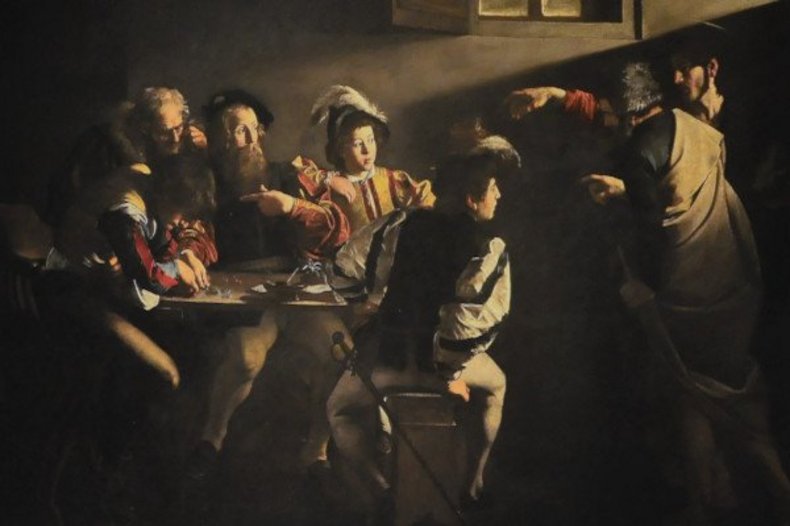
Caravaggio, The Vocation of Matthew, 1600, Church of St Louis of the French, Rome / © CC0/wikimedia
Les raisons d'y croire :
- The composing, writing and publishing of Matthew's Gospel is better known today, as is the cultural, economic, linguistic, intellectual, material and liturgical background - the society of Israel in the 1st century - all of which confirms the early writing and reliability of the New Testament texts.
As with all the apostles, the change in Matthew's behaviour between the arrest of Jesus (start of his Passion), when all but John abandoned Christ (John came back after fleeing first), and the start of evangelisation, when they gave their all for him, can only be explained by the "many proofs" (Acts 1:3) given by Jesus of his Resurrection and by the gift of the Holy Spirit at Pentecost (Acts 2:1-47). This great change is a strong argument in favor of Christianity.
- Matthew thus became, like all the others, a fearless and unwavering witness to Christ, who sealed his testimony with the martyrdom of blood.
- His Gospel is a credible, remarkable and truthful witness to Christ, written for the Jews, and especially shows how Jesus perfectly fulfilled Israel's prophecies and expectations.
- The remains and relics of Saint Matthew are enshrined today in the basilica that bears his name in Salerno, Italy. Many miracles and healings are attested there.
Synthèse :
The Gospels were composed around the time the birth of the Church, after Pentecost, in the Jewish world of the 1st century. At that time, the Mesopotamian culture, the oldest in the world, dominated the region: it was in this culture that writing, trade and the first scientific knowledge were born. The language spoken in Israel at the time of Christ was the Aramaic of the Parthian Empire, the great trading language used throughout the East, from the shores of the Mediterranean to India, and on all the trade routes of Antiquity.Hebrew was only a liturgical language (a bit like Latin for us), and Greek was an international language, but mainly in the Mediterranean, as were Latin and Phoenician, although Alexander's conquests also made it known in the East.
Life in Israel at the time of Christ was structured around three levels of the Torah: daily domestic practice, including readings and prayers; practice in the synagogue, where people gathered especially on the Sabbath for prayer, reading and commentary on the Scriptures (the Torah, divided into 52 parts, allows continuous reading throughout the Sabbaths, from Genesis to Deuteronomy, incorporating all the Jewish liturgical festivals) and visits to the Temple, with the six feasts (holiday) celebrated there during the winter cycle, from October to June, with Rosh Hoshana, Yom Kippur, the Feast of Tents, the Dedication of the Temple, Passover (Pesach) and Pentecost (Shavuot), all of which are also linked to specific texts. The summer cycle, with no festivals, is more or less the equivalent of our "ordinary time". Each week, and for each festival, a section of the Torah and a text from the prophets are proclaimed. There is no other canonical Scripture than the Torah, the prophets and the psalms.
Christ's preaching is based on the liturgical life of Israel as it goes through the Torah. Jesus positioned himself in relation to these texts of the Torah and the prophets read in the synagogues (Lk 4:15) and in the Temple. He commented on them and gave them a messianic development, which took place in connection with specific dates, places and significant events. For example, on the last day of the Feast of Tabernacles (Jn 7:2), when Christ spoke in the Temple of "rivers of living water" that would flow from "within him" (Jn 7:37-38), it was a direct commentary on the texts of Zechariah (Zech 14:8) and Ezekiel (Ezek 47:1-12) that were read on that day. Or again, at the Synagogue of Nazareth, "according to his custom" Jesus read from the prophet Isaiah, and commented with a messianic development: "Today is fulfilled that passage of Scripture which you have just heard" (Lk 4:16-21).
After Jesus, the apostles preached the New Covenant in a Jewish context.All the protagonists were Israelites: the apostles, the disciples, the converts, the opponents, and they all went to the synagogue during the week and to the Temple for the festivals, taking part in the same services. The apostles were questioned in the supreme court, the Sanhedrin, where Peter and John gave legally valid testimony, and they also preached under Solomon's colonnade, in the Temple, or in private, orally, from master to disciple, following the example of Christ. They concentrated on this preaching, as "witnesses" (Acts 1:8) of everything they had seen and heard "from John's baptism to the day Jesus was taken up" (Acts 1:22). Depending on the liturgical season, they were naturally led to recall the corresponding teachings of Christ, and this is how an organic, oral catechesis was very quickly established, based on the readings from the Holy Scriptures of Israel, which remained the only "written" texts".
The apostles' teaching therefore naturally followed the pacing of the synagogue calendar, recalling every Sunday after the Sabbath the deeds and actions that Christ had performed in accordance with the Sabbatical readings. Recently, researchers have shown that the Gospels of Matthew and Luke correspond to the synagogue texts of the eight months of the winter cycle - the Gospel of Mark can, it seems, be matched to the texts of the four months of the summer cycle. This would suggest that the Synoptic Gospels were built up from the lectionaries of the early Church - John's Gospel, based on the Temple festivals, being a supplementary teaching, intended for listeners who were already initiated. Thus, just as Jesus taught the crowds in parables and explained everything in detail to his disciples (Mt 4:34), and Paul distinguishes between beginners who should be given "milk" and those who are more advanced, who can take "solid food" (1 Cor 3:1-2), the apostles did the same: a general public teaching, and a more in-depth teaching related to it (many have noted that there is clearly a division of accounts: the Synoptic Gospels do not, for example, speak of the resurrection of Lazarus, which was a major event, and the Gospel of John says nothing about the institution of the Eucharist, which is yet at the heart of the events of the Last Supper, reported by John in great detail. This shows that the two teachings are related).
Thus, according to the testimony of Saint Irenaeus , around 180, "Matthew published among the Hebrews, in their own language, a written form of the Gospel at the time when Peter and Paul were evangelising Rome and founding the Church" (Against Heresies III 1,1). Eusebius of Caesarea (265 - 340) confirms this in his Ecclesiastical History, adding that, of the apostles, "Matthew and John alone left records of the Lord's teachings. And tradition records that they came to write out of necessity" (EH 3,24,5), i.e. the apostles prioritised oral teaching, which was the norm, but the written word could be used in case of need (dispersion, departure on a mission, persecution, etc.). "Tradition records that they came to write out of necessity. Matthew preached first to the Hebrews. Since he also had to go to other nations, he wrote his Gospel in his mother tongue, making up for his absence by writing for those he had to leave. Whereas after this Luke and Mark published a Gospel in writing for the reasons we have already mentioned (they were moving away from their community), John, it is said, continued his preaching all the time without writing it down. Finally, he also wrote, for the following reason. Although the three Gospels written earlier had already been passed on to all (the faithful) and to him as well, he received them, it is said, bearing witness to their truth. But their writings lacked the only account of the things done by Christ in the early days and at the beginning of his preaching" (EH 3,24,8). Eusebius of Caesarea also reports that a certain Panthenes, "who went as far as India [...] found his coming anticipated by the Gospel of Matthew among certain natives of the country who knew Christ. Bartholomew, one of the apostles, is said to have preached to these people and to have left them Matthew's book written in Hebrew letters, which they kept until the time we are speaking of" (EH 10,2) and there are several other comparable accounts.
Matthew's Gospel, which is addressed to the Jews, is therefore certainly the first Gospel to have been composed and distributed, as the Vatican's Biblical Commission taught as early as 1911, when pronouncing on questions related to this subject: "Is the opinion that Matthew preceded the other evangelists in his writing and that he composed the first Gospel in the mother tongue then used by the Jews of Palestine, to be considered sufficiently well-founded by tradition? The answer is 'yes' to both" (Denzinger n. 3562); and "with regard to the chronological order of the Gospels, is it permissible to depart from the opinion corroborated by the very ancient and constant testimony of Tradition, which attests that after Matthew, who was the first to compose his Gospel in his mother tongue, Mark wrote the second, and Luke the third. And should, on the other hand, the opinion that the second and third Gospels were composed before the Greek translation of the first Gospel be regarded as contrary to this view? The answer is no to both." The Commission also points out that the Gospel of Matthew "does not always follow chronological order" (Denzinger n. 3566), which is logical becauseit is based on a single liturgical year. As several Fathers of the Church have also noted, there is only one mention of Jesus "going up to Jerusalem for Easter", even though he went there every year during the three years of his public life. Matthew's is also, of course, the Gospel that is most addressed to a Jewish audience because, in the first years of his preaching, all the protagonists - apostles, disciples, opponents, teachers and listeners - were Jews. The apostles followed the command of Christ, who had asked them first of all to be his witnesses "in Jerusalem and all Judea and Samaria" before being his witnesses to the ends of the earth" (Acts 1:8).
The better understanding we have today of the process of composing, writing and publishing Matthew's Gospel gives us new arguments about the reliability and speed of the genesis of these texts. It is clear that every time a miracle or significant event occurred, the disciples and witnesses recounted it dozens of times: "Then he took five loaves and two fish etc." Anyone who has experienced this kind of transmission knows that, under these conditions, the stories become clearer and more fixed very quickly. This is even truer in an oral culture, such as that of the Jewish world after the Exile, which benefited from Mesopotamian techniques for composing and memorising texts. And Christ himself used all the attention, organisational skills and method of the Jewish people (cf. the whole of the Old Testament) to ensure that preaching was precise. Subsequently, the apostles repeated a hundred times all the deeds and actions of Jesus that they had witnessed, "from the beginning, when John baptized him, to the day he was taken up " (Acts 1:21-22), and all these teachings were therefore naturally and definitively fixed very early on, from the first years of preaching, in Jerusalem and Israel, in the 30s. At the beginning, it was a matter of commenting on the Scriptures throughout the liturgical year, and these accounts were only written and distributed in Gospel form later, according to needs and necessities, when persecutions and missions led the apostles to disperse and move away.
Matthew, for his part, was probably from the tribe of Levi and, according to tradition, went to preach on the incense route to Arabia and Ethiopia. At the time of Christ, the Jewish people numbered, according to estimates, between 4 and 8 million, roughly half of whom lived in Israel and half in a huge diaspora that was unique in the world, present in every region of the ancient world, from China to England, with particularly large communities in Rome, Egypt and Mesopotamia. It is estimated that the Jews represented between 5 and 10% of the Roman Empire, making them a large and influential community. Major trade routes crossed the ancient worldaround Israel, which occupied a central position on the "Silk Roads" in particular, from the Mediterranean to China, but also on the "Incense trade routes" to the Arabian Peninsula and Africa, and on the "tin route" to Spain, Western Europe and England. The Jews were the main organisers of this trade: they ran the trade from China to Spain with the help of their diaspora. Their ancient trade routes were highly organised and enabled the exchange and trade of spices, textiles, precious stones, precious metals, technology and the sharing of religious and philosophical ideas, and the apostles used these connections to spread the Gospel.
Finally, Matthew gave the ultimate testimony to Christ by his martyrdom, in 61, at Naddarer, in southern Egypt. According to the venerable tradition recorded in the Roman Martyrology, the Virtutes Apostolorum (6th century) and the Golden Legend (13th century), he was assisted in Ethiopia by the eunuch of Candace, the Queen of Ethiopia, who is mentioned in the Acts of the Apostles (Acts 8:26-39). Two sorcerers, Zaroes and Arfaxar, told the king that they could not save his dying son Euphranor, but the eunuch brought Matthew to the court and the apostle managed to save the young prince. The king and his family converted, encouraging the Christianisation of the country. The next king, Hyrtaque, wanted to marry Iphigenia, a virgin consecrated to Christ, but Matthew refused. After 23 years on mission in Ethiopia, he died a martyr in Naddarer in 61, after the king had sent one of his soldiers to put the apostle to the sword. His body was transferred to Salerno, Italy, where a basilica bearing his name was built around his relics: today it is an important place of pilgrimage, and many miracles and healings have been recorded there. In 2014, Pope Francis ordered a scientific study of the relics to confirm their authenticity. The results of the study have not been made public, but Pope Francis has confirmed that the relics are indeed authentic.
Matthew was celebrated by Caravaggio, who, in his famous painting (see our illustration), makes it clear how surprising it is that Christ chose Matthew, the publican, to be one of his closest friends - one of the Twelve - and that is why the theme of mercy is so strong and present throughout Matthew's Gospel: "Those who are well do not need a physician, but the sick do. Go and learn the meaning of the words, ‘I desire mercy, not sacrifice.’ I did not come to call the righteous but sinners" (cf. Mt 9:9-1).
Olivier Bonnassies
Au-delà des raisons d'y croire :
Like all the Gospels, the Gospel of Matthew deserves to be read and meditated on, because the word of God speaks for itself. As Christ says, his sheep "recognise his voice" (Jn 10:26-27).
Aller plus loin :
The film Jesus of Nazareth by Franco Zeffirelli (1977), a magnificent retelling of the life of Christ based on the Gospel of Matthew.










